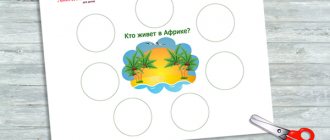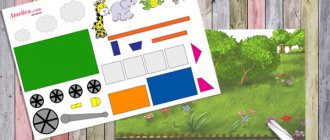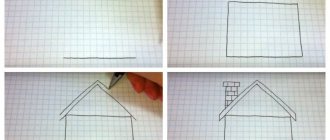November 09, 2016
Averyanova Sveta
The formation of graphic skills is necessary for the development of writing, drawing, and number drawing skills. Kindergarten teachers and parents use different exercises and tasks. One of the most effective and interesting techniques is graphic dictations.
Parents and teachers in “developmental” schools can dictate a simple drawing or instructions for the diagram, and children 5-6 years old are indescribably delighted with the results obtained. Let's talk about this method of preparing for school in more detail.
How to complete the task
- Print out the proposed tasks for children on A4 or A5 sheets.
- There is a red dot on each sheet - the graphic dictation will begin from this place.
- Explain to your child that 1 step is one cell. 2 steps - 2 cells, and so on. Each step occurs from one corner of the cell to the next in a given direction.
- It is necessary to clarify the concepts of “right”, “left”, “up”, “down” and “diagonally”.
- You can perform graphic dictation directly under dictation, or independently using the arrows at the top of each sheet.
- Great concentration and attentiveness are required, since even 1 mistake will lead to the drawing not working out. When used in classes at home with mother, mother's supervision is recommended.
Required Instructions
To conduct developmental classes with young children and older preschoolers you will need:
- a squared notebook for each child. For younger preschoolers it is better to choose a large cage, for older and first-graders - a small one;
- simple and multi-colored pencils;
- eraser;
- form with a sample picture;
- instructions for the teacher;
- ruler if the lines are long or diagonal;
- card file with drawings.
The first lesson will be a trial lesson. On it you need to explain to the kids the principle of work, the goals and objectives of the exercise “Drawing by cells”. Try to make the lesson fun and exciting so that the young student is interested.
Give verbal instructions clearly and clearly. Talk to your children about all the stages of work:
- Let's create a magical picture from different dashes. These will be enchanted figures. You need to decipher them by making notes on a piece of paper.
- If you follow my instructions and requests correctly, do not confuse right and left, and carefully count the cells, you will get an amazing result.
- I will say: “Draw a line on the form to the left by 2 cells, to the right by 4 cells.” You draw a nice, even line without lifting your hand from the paper.
- Let's practice together on the board. As an example, let’s draw a very simple drawing from dictation. And then you will do another option without prompts and, for example, draw a vase.
After completing a simple logical task, offer preschoolers more complex schemes for independent work. When you receive the correct answer, be sure to praise the guys. Print out certificates of commendation, stars, make a personal growth board for each student.
If children have many difficulties with such exercises, the teacher should analyze the methodology and common mistakes. It is advisable to keep a lesson protocol and record the final result for each lesson. Thus, the dynamics of the development of skills and abilities of preschool children can be traced.
Perhaps the level of complexity of the pictures is not suitable for age, development of skills.
If the child is only 4 years old or a little older, then use simpler templates and increase the time to complete the task. There is no need to independently develop or compose descriptions for pictures for dictations.
Print easy graphic dictations
To download the picture you like, click on it to enlarge. After that, save the image to your device. This way you can print out graphic dictations for free for personal use.
Drawing according to instructions with arrows
This method differs from dictation by less control on the part of teachers. The child is given a piece of paper with a dot and a small instruction, usually in the form of arrows with the number of cells. The child draws a picture at his own pace.
You can conduct a workshop for beginners and young children to explain how the task is performed. This method perfectly trains perseverance and attentiveness in children.
Graphic dictations by cells free download
Graphic dictations on a gray field in PDF format
Graphic dictations on a yellow field in PDF format
Symmetry
The baby is given half of the drawing and must complete the other half himself, maintaining symmetry. The technique affects spatial orientation, thinking, the ability to compare and find one’s own mistakes.
Print oral graphic dictations with answers
They try to make tasks for oral dictation a little simpler than those tasks that are done “from sight”, since they require more preparation and concentration. There are no diagonal lines in them. They are also provided with a picture answer to quickly show children an image of the correct solution.
If you find it difficult to unravel abstract images, here is a hint: the following are encrypted: sailboat, dragon, snowflake, bear, lion, car, chair, ladybug, hippopotamus, ship, octopus, hare, snowman, boat, turtle.
Veronica
The formation of graphic skills is necessary for the development of writing, drawing, and number drawing skills. Kindergarten teachers and parents use different exercises and tasks. One of the most effective and interesting techniques is graphic dictations.
Parents and teachers in educational programs can dictate a simple drawing or instructions for the diagram, and children are indescribably delighted with the results obtained. Let's talk about this method of preparing for school in more detail.
What is graphic dictation
Preschoolers enjoy unusual didactic activities. They do not require deep knowledge or strong mental tension from the child. Such methods of work also include graphic dictations in cells.
This is a game in which the child draws lines and diagonals on a piece of paper and as a result gets a picture. It's easy to do. You just need to listen carefully to the teacher, draw lines with a pencil left, right, up or down. By developing motor skills, the baby learns to count, navigate in space, evaluate himself and enjoy the success of his classmates.
If a preschooler gapes and gets distracted, the picture won’t come together. The child realizes the importance of being attuned to the lesson, vigilance and seriousness in the process of future learning at school.
For graphic dictations, simple pictures are used. For example, a house, a dog, a car. The images should be familiar to children and not require a long execution time.
The benefits of mathematical dictations
Graphic dictation for preschoolers is a useful technique for diagnosing the level of development and preparing for school in kindergarten and at home. In preschool educational institutions, educators more often use manuals by the authors: D.B. Elkonina, O.A. Kholodova. K.V. Shevelev developed a whole course of step-by-step lessons for children 4–5 years old, 5–6 years old, as well as first-graders. Special notebooks develop the following skills and abilities in preschool children from the preparatory group:
- coordination of movements;
- attention;
- memory;
- perseverance;
- imagination;
- lexicon;
- fine motor skills;
- spelling vigilance.
At the same time as physical skills, the child increases self-esteem. He is aware of the need to listen to instructions. Does the job clearly and quickly, without being distracted by a bird in the window or the laughter of a neighbor at his desk.
Another goal of graphical mathematics is to broaden one's horizons. You need to select pictures according to the age and level of development of the children, but this is only at first. Later, draw pictures that are unfamiliar to preschoolers. After drawing such an arithmetic problem on a piece of paper, tell a story about an unusual animal, introduce it to its habitat, and show a photograph.
Numerical dictation assignments are a good way to adapt kindergarteners to school. They teach six-year-olds independence and orientation in a new space. This will help in mastering the elementary school curriculum, when meeting a new team and teacher.
By the way, read this article too: Classic copybooks for preschoolers. We read syllables and write
The ability to hold a pencil, follow oral instructions, decipher text, and write is an excellent foundation for preparing for first grade. You can ask your child to print out sheets, templates, and help interpret instructions. This helps to introduce the future preschooler to office equipment and instill respect for elders.
Execution Rules
Graphic dictations are best used in math lessons, for example in 1st grade. Execution is related to the coordinate system, counting, and geometric shapes. The methodology consists of several stages:
- Prepare a piece of squared paper for the student. Keep a ready-made version of the dictation with you.
- Place a dot on the student paper. This will be the start of the countdown. Or have your preschooler do it themselves, explaining how much space to give.
- For a child just beginning to learn, draw arrows on paper that indicate the directions of the sides. This makes it easier to get the correct result. In subsequent lessons, hints will no longer be needed.
- Explain that step 1 is a cage. If we take 2 steps, the line goes 2 cells.
- The teacher dictates the working conditions step by step.
On the finished sheet for the teacher there is a drawing, a coordinate plane consisting of arrows and numbers. For example, to draw a Christmas tree, draw a line horizontally in 1 cell, vertically - 3 cells, diagonally - 3 cells, and so on. More often it’s just arrows and numbers without words.
The teacher explains which lines, where, and at what distance the preschoolers draw. Instructions are given one after another, without rushing.
After completing the written assignments and obtaining the results, draw conclusions about the lesson and the efforts of the preschoolers. Scold him for inattention if the child was distracted by trifles, or praise him for his achievements.
Important! There's no need to rush. If your preschooler doesn’t keep up, usually in the first lessons, wait for him. Skipping even one step or writing incorrectly will ruin the finished result. Set the time frame gradually, speeding up the process by a couple of seconds from lesson to lesson.
Required Instructions
To conduct developmental classes with young children and older preschoolers you will need:
- a squared notebook for each child. For younger preschoolers it is better to choose a large cage, for older and first-graders - a small one;
- simple and multi-colored pencils;
- eraser;
- form with a sample picture;
- instructions for the teacher;
- ruler if the lines are long or diagonal;
- card file with drawings.
The first lesson will be a trial lesson. On it you need to explain to the kids the principle of operation, the goals and objectives of the exercise. Try to make the lesson fun and exciting so that the young student is interested.
- Give verbal instructions clearly and clearly. Talk to your children about all the stages of work:
- Let's create a magical picture from different dashes. These will be enchanted figures. You need to decipher them by making notes on a piece of paper.
- If you follow my instructions and requests correctly, do not confuse right and left, and carefully count the cells, you will get an amazing result.
- I will say: “Draw a line on the form to the left by 2 cells, to the right by 4 cells.” You draw a nice, even line without lifting your hand from the paper.
- Let's practice together on the board. As an example, let’s draw a very simple drawing from dictation. And then you will make another option without prompting.
By the way, read this article too: How to make New Year's compositions with candles with your own hands
After completing a simple logical task, offer preschoolers more complex schemes for independent work. When you receive the correct answer, be sure to praise the guys. Print out certificates of commendation, stars, make a personal growth board for each student.
If children have many difficulties with such exercises, the teacher should analyze the methodology and common mistakes. It is advisable to keep a lesson protocol and record the final result for each lesson. Thus, the dynamics of the development of skills and abilities of preschool children can be traced.
Perhaps the level of complexity of the pictures is not suitable for age, development of skills. Use simpler templates, increase the time to complete the task. There is no need to independently develop or compose descriptions for pictures for dictations.
Methods of execution
There are several methods for conducting dictations:
Auditory. The child draws a graph or a picture from dictation. The teacher gives verbal instructions about how many cells and in which direction the line should be drawn. After finishing the work, compare the result with the sample. This technology develops attention, brain concentration when performing complex tasks, and child concentration.
Drawing from a sample. Print the finished template. Place it on the table in front of your child. Let him copy it into his notebook. It is important to look carefully at the direction of the line and count the cells. Get your baby interested in figures and diagrams. The girl will be happy to copy a small pattern, flowers; boy – geometric shapes, cars, animals. For 4-5 year old preschoolers, choose a simple pattern with approximately the same lines; for six year olds, choose a more complex one, where there are diagonal lines, long and short. The technology involves the development of visual attention, its stability, and perseverance.
Drawing symmetry. The blank is an unfinished drawing made on one side. The kindergartener needs to complete half the picture on his own, maintaining symmetry.
By the way, read this article too: How to fold a napkin in the shape of an Asian fan
The technique develops spatial orientation and thinking.
Time frame
The duration of the lesson depends on the age of the preschool children. Consider their readiness for serious activities and their level of perseverance. If you plan too long lessons with your children, they will get tired, you will lose time and energy, and if they are too short, you will not have time to complete the required work. It is better for teachers and parents to focus on the time frames established by psychologists:
- For kindergarteners aged 5, do written work for no more than 15 minutes.
- With six-year-olds – 15–20 minutes.
- Keep first-graders at their desks for no more than half an hour, at least 20 minutes.
Graphic exercises seem to be straightforward tasks for preschoolers, simple and sometimes unnecessary. This is a misconception. Such lessons help children grow up confident, with adequate self-esteem, developed attention and perseverance. And this will be useful for adapting to school.
Useful tips
In the process of mastering mathematical science and new concepts, the baby and mother encounter some difficulties. Advice from experienced teachers will help you overcome them.
- Before starting classes, clearly and clearly explain to your child what you want to get in the end, why these lessons are needed, what knowledge the preschooler will receive. This information is necessary for the future first-grader to motivate actions and interest in the learning process.
- Don't rush to blame for mistakes. Take them apart and fix them. Create a friendly atmosphere.
- Do not overload your child with complex schemes from the first lessons. Some time must pass for the kindergartener to firmly grasp the concepts of left - right, up - down. Select pictures taking into account the individual characteristics of intellectual development and the speed of drawing. Give preference to symmetrical patterns for slow kids, repeat the instructions for them several times.
- Sloping lines are difficult for young students. Explain in advance what a diagonal is, how it is laid, and allow you to use a ruler.
- Watch your posture and hand position. The piece of paper should lie straight on the table, the back should not bend while writing.
- Keep it quiet if kindergarteners have trouble concentrating. For children with hyperactivity, absent-mindedness, or mental retardation, it is better to have individual lessons and print diagrams for additional exercises at home.
- Be happy about the positive outcome. Even if the result of the work is average, be sure to praise the preschooler for his efforts.
- Make changes. In between exercises, read funny poems to warm up your fingers, jump, play.
Even more useful educational articles for your kids on our website! Did you like the article? Share with your friends.
Post Views: 30,161
Dictations for independent work
These tasks, where the dictation field and the “path” with arrows are located next to each other, are convenient to use for independent work.
Explain to your child that movement along the arrows begins with a dot. The signs should be read from left to right horizontally .
Recommendations for classes
Sometimes during lessons with a child various difficulties may arise. To prevent this from happening, it is better not to forget a few tips from experienced teachers.
- Before the first lesson, you need to explain to your child the essence of the game. It's best to show with a simple example. Explain why the lesson is being taught. Motivate for successful execution.
- The teacher should give step-by-step instructions, noticing whether the child is keeping up. All questions that arise must be answered immediately, without delaying until the end of the lesson. It is better not to repeat directions several times, so as not to confuse preschoolers.
- You need to carefully monitor the correct posture and position of the baby’s hands. Correct if the child is hunched over or holding a pencil incorrectly.
- It is advisable to ensure a calm atmosphere and silence in the classroom. This will help the baby concentrate and better perceive the teacher’s instructions.
- Make sure there is good lighting while practicing. This will make it much easier to complete tasks and help maintain good vision.
- The difficulty of tasks should be increased gradually. You should not immediately give complex drawings with many details, and on the contrary, a task that is too simple will seem boring to the child.
- There is no need to scold your child for mistakes. Don't forget, your child is just learning.
- Always notice your baby's successes. This will help him build self-confidence.
- It is necessary to control the time of classes so as not to overtire the child. Take small warm-up breaks periodically.
Reverse task
If your child confidently and happily completes tasks in the cells under dictation and independently, offer him the task in reverse . You give a sample drawing, and the child encodes the movements of the pencil from the starting point: 2 up, 3 to the left, 1 down, 2 to the right, etc...
You don’t need to know how to write - the direction can be indicated with arrows. But knowing the numbers is a must!
To get started, you can use the pictures below, and then go even further: offer not only to encrypt the picture yourself, but first draw it on checkered paper!
Methods of execution
There are several methods for conducting dictations using the Minecraft method in cells:
- Auditory.
The child draws a graph or a picture from dictation. The teacher gives verbal instructions about how many cells and in which direction the line should be drawn. After finishing the work, compare the result with the sample.
This technology develops attention, brain concentration when performing complex tasks, and child concentration.
- Drawing from a pattern.
Print the finished template. Place it on the table in front of your child. Let him copy it into his notebook. It is important to look carefully at the direction of the line and count the cells. Get your child interested in magical figures and diagrams. The girl will be happy to copy a small pattern, flowers; boy – geometric shapes, cars, animals. For 4-5 year old preschoolers, choose a simple pattern with approximately the same lines; for six year olds, choose a more complex one, where there are diagonal lines, long and short.
The technology involves the development of visual attention, its stability, and perseverance.
- Drawing symmetry.
The blank is an unfinished drawing made on one side. The kindergartener needs to complete half the picture on his own, maintaining symmetry.
The “Complete the mirror image” technique develops spatial orientation and thinking.
If it’s difficult for a child...
If it is difficult for a child to complete tasks on cells with arrows, perhaps you have simply not yet worked out the meaning of the arrows, the concepts of “right, left, top, bottom.” Start with simple arrow exercises like these to get the vocabulary right.
Rules and tips for implementation
Graphic drawings in the cells should be done after the teacher’s introductory speech, conversation with the class (group of children) and preparation:
- Let the child pick up the ball and toss it several times.
- Next, for each syllable of the tongue twister (pure twister), the baby must catch the ball. This is how a sense of tact and an understanding of sequence develops. Children will not rush anywhere.
Finger gymnastics promotes the correct execution of graphic drawings
- The ball can be replaced by clapping your hands - for each syllable the child makes a clap.
- Finger gymnastics allows you to prepare children to complete the task. To prevent the kids from being interrupted, you can hand out sheets and pencils while reading and telling tongue twisters.
- Next, you need to explain the game plan so that the children are not afraid of being late with the work.
- Before starting, you should read the terms of the game several times, and then use an example to show what can happen if you follow all the points correctly and consistently.
Before dictating a task to the children, you need to ask them to put a dot - this is the beginning from where the drawing will “grow”. It is important that the point does not end up on the edge or in the middle of the drawing, which takes up a lot of space on the work surface.
Graphic dictations for school preparation
If the presented tasks did not seem enough to you, do not waste time searching for pictures in Yandex or Google.
Printing materials on various sites are often of poor quality, and there are errors in the dictation text, which completely kills the child’s desire to study further.
Here: print out assignments to prepare for school.
Ready-made manuals with graphic dictations are inexpensive and interesting . Here are examples.
Dictations from the book 5+ “Funny Cells. Graphic dictations. To prepare for school."
A very interesting set of tasks in Elena Uleva’s manual “Super developmental tasks for first graders. Graphic dictations for first graders"
Scans of tasks from the series “Waco. On the way to school. Graphic dictations"
Spreads of the notebook “Graphic dictations. Attention training. 1 class":
From the manual “Graphic dictations. From simple to the most complex. Guidelines for activities with children aged 5-7 years:
Time frame
The duration of the lesson “Drawing by cells” depends on the age of the preschool children. Consider their readiness for serious activities and their level of perseverance. If you plan too long lessons with your children, they will get tired, you will lose time and energy, and if they are too short, you will not have time to complete the required work. It is better for teachers and parents to focus on the time frames established by psychologists:
- For kindergarteners aged 5, do written work for no more than 15 minutes.
- With six-year-olds – 15–20 minutes.
- Keep first-graders at their desks for no more than half an hour, at least 20 minutes.
Graphic exercises seem to be straightforward tasks for preschoolers, simple and sometimes unnecessary. This is a misconception. Such lessons help children grow up confident, with adequate self-esteem, developed attention and perseverance. And this will be useful for adapting to school.







